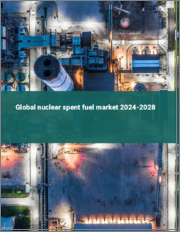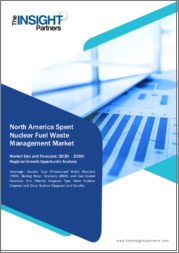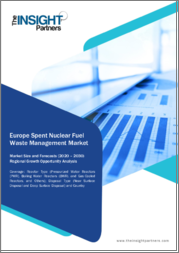
|
시장보고서
상품코드
1681660
세계의 핵폐기물 관리 시장 규모, 점유율, 성장 분석 : 폐기물 유형별, 형태별, 용도별, 지역별 - 산업 예측(2025-2032년)Nuclear Waste Management Market Size, Share, and Growth Analysis, By Waste Type (Low-Level Waste, Intermediate-Level Waste), By Form (Industrial, Utility), By Application, By Region - Industry Forecast 2025-2032 |
||||||
핵폐기물 관리 시장 규모는 2023년 48억 9,000만 달러로 평가되었습니다. 또한, 2024년 49억 8,000만 달러에서 2032년에는 57억 9,000만 달러로 성장하고, 예측 기간(2025-2032년) 동안 1.9%의 연평균 복합 성장률(CAGR)을 보일 것으로 예측됩니다.
세계적으로 원자력 발전에 대한 의존도가 높아짐에 따라 안전하고 효율적인 핵폐기물 처리 솔루션에 대한 수요가 증가함에 따라 핵폐기물 관리 시장이 크게 성장하고 있습니다. 이러한 추세의 주요 원동력은 원자력 에너지 생산의 확대와 환경 친화적인 폐기물 처리 방법에 대한 인식 증가입니다. 규제의 복잡성, 대중의 불안감, 높은 개발 비용 등의 문제에도 불구하고, 업계는 첨단 폐기물 관리 기술을 적극적으로 모색하고 있습니다. 현재 시장 인사이트은 심지층 처분장 및 강화된 폐기물 처리 방법을 포함한 혁신적인 솔루션으로의 전환을 보여주며, 방사성 폐기물 문제에 대한 적극적인 접근 방식을 보여주고 있습니다. 이러한 변화하는 상황은 환경과 공공 안전에 대한 우려를 효과적으로 해결하려는 업계 관계자들의 노력을 반영하고 있습니다.
목차
서론
- 조사 목적
- 조사 범위
- 정의
조사 방법
- 정보 조달
- 2차와 1차 데이터 방법
- 시장 규모 예측
- 시장 전제조건과 제한
주요 요약
- 세계 시장 전망
- 공급과 수요 동향 분석
- 부문별 기회 분석
시장 역학과 전망
- 시장 개요
- 시장 규모
- 시장 역학
- 성장 촉진요인과 기회
- 성장 억제요인과 과제
- Porter의 Five Forces 분석
주요 시장 인사이트
- 중요 성공 요인
- 경쟁 정도
- 주요 투자 기회
- 시장 생태계
- 시장의 매력 지수(2024년)
- PESTEL 분석
- 거시경제 지표
- 밸류체인 분석
- 가격 분석
핵폐기물 관리 시장 규모 : 폐기물 유형별&CAGR(2025-2032년)
- 시장 개요
- 저레벨 폐기물
- 중간레벨 폐기물
- 고레벨 폐기물
핵폐기물 관리 시장 규모 : 형태별&CAGR(2025-2032년)
- 시장 개요
- 산업
- 유틸리티
핵폐기물 관리 시장 규모 : 용도별&CAGR(2025-2032년)
- 시장 개요
- 가압수형 원자로
- 비등수형 원자로
- 가스 냉각로
- 가압 중수로
핵폐기물 관리 시장 규모 : 지역별&CAGR(2025-2032년)
- 북미
- 미국
- 캐나다
- 유럽
- 독일
- 스페인
- 프랑스
- 영국
- 이탈리아
- 기타 유럽
- 아시아태평양
- 중국
- 인도
- 일본
- 한국
- 기타 아시아태평양
- 라틴아메리카
- 브라질
- 기타 라틴아메리카
- 중동 및 아프리카
- GCC 국가
- 남아프리카공화국
- 기타 중동 및 아프리카
경쟁 정보
- 주요 5개사 비교
- 주요 기업의 시장 포지셔닝(2024년)
- 주요 시장 기업이 채택한 전략
- 최근 시장 동향
- 기업의 시장 점유율 분석(2024년)
- 주요 기업 개요
- 기업 상세
- 제품 포트폴리오 분석
- 기업 부문별 점유율 분석
- 매출 전년대비 비교(2022-2024년)
주요 기업 개요
- Fluor Corporation(United States)
- Bechtel Corporation(United States)
- Jacobs Engineering Group Inc.(United States)
- AECOM(United States)
- Babcock International Group PLC(United Kingdom)
- Veolia Environmental Services(France)
- Orano(France)
- JGC Corporation(Japan)
- Hitachi Zosen Corporation(Japan)
- Korea Hydro & Nuclear Power(South Korea)
- Cameco Corporation(Canada)
- Bharat Heavy Electricals Limited(BHEL)(India)
- Larsen & Toubro Limited(L&T)(India)
- Rosatom(Russia)
- Kazatomprom(Kazakhstan)
- China National Nuclear Corporation(CNNC)(China)
결론과 제안
LSH 25.04.23Nuclear Waste Management Market size was valued at USD 4.89 billion in 2023 and is poised to grow from USD 4.98 billion in 2024 to USD 5.79 billion by 2032, growing at a CAGR of 1.9% during the forecast period (2025-2032).
As the global reliance on nuclear power rises, so too does the demand for safe and efficient nuclear waste disposal solutions, positioning the Nuclear Waste Management market for significant growth. The key drivers of this trend are the expansion of nuclear energy production and heightened awareness regarding environmentally responsible waste disposal methods. Despite challenges such as regulatory complexities, public apprehension, and high development costs, the industry is actively seeking advanced waste management technologies. Current market insights reveal a shift towards innovative solutions, including deep geological repositories and enhanced waste treatment methods, indicating a proactive approach to nuclear waste challenges. This evolving landscape reflects a commitment from industry stakeholders to address environmental and public safety concerns effectively.
Top-down and bottom-up approaches were used to estimate and validate the size of the Nuclear Waste Management market and to estimate the size of various other dependent submarkets. The research methodology used to estimate the market size includes the following details: The key players in the market were identified through secondary research, and their market shares in the respective regions were determined through primary and secondary research. This entire procedure includes the study of the annual and financial reports of the top market players and extensive interviews for key insights from industry leaders such as CEOs, VPs, directors, and marketing executives. All percentage shares split, and breakdowns were determined using secondary sources and verified through Primary sources. All possible parameters that affect the markets covered in this research study have been accounted for, viewed in extensive detail, verified through primary research, and analyzed to get the final quantitative and qualitative data.
Nuclear Waste Management Market Segments Analysis
Global Nuclear Waste Management Market is segmented by Waste Type, Form, Application and region. Based on Waste Type, the market is segmented into Low-Level Waste, Intermediate-Level Waste and High-Level Waste. Based on Form, the market is segmented into Industrial and Utility. Based on Application, the market is segmented into Pressurized Water Reactors, Boiling Water Reactors, Gas-Cooled Reactors and Pressurized Heavy Water Reactor. Based on region, the market is segmented into North America, Europe, Asia Pacific, Latin America and Middle East & Africa.
Driver of the Nuclear Waste Management Market
The increasing reliance on nuclear power as a sustainable, low-carbon energy option amplifies the necessity for efficient nuclear waste management. As environmental awareness continues to rise, both governments and industries are compelled to address the challenges associated with nuclear waste disposal in a safe manner. Furthermore, advancements in reprocessing and immobilization technologies offer innovative solutions for treating nuclear waste, enhancing the commitment to environmental preservation. This intersection of growing energy demands, regulatory pressures, and technological innovations underscores the importance of developing robust waste management strategies that align with environmental goals while ensuring public safety and sustainability in the nuclear sector.
Restraints in the Nuclear Waste Management Market
The Nuclear Waste Management market faces significant constraints primarily due to the stringent regulations stemming from the intricate legal framework governing nuclear waste disposal. Additionally, public opposition plays a critical role in limiting market growth, as there is a widespread lack of awareness regarding the environmental challenges associated with nuclear waste management. This public apprehension is often rooted in fear for personal safety, which can hinder acceptance and support for facilities and processes aimed at safe nuclear waste disposal. Together, these factors create a challenging environment for the advancement and acceptance of nuclear waste management solutions.
Market Trends of the Nuclear Waste Management Market
The Nuclear Waste Management market is witnessing a significant trend driven by an increased focus on research and development aimed at advancing waste treatment technologies. This includes the exploration of innovative re-processing agents and alternative disposal methods to enhance efficiency and safety. Furthermore, there is a growing wave of international collaboration, as countries facing similar nuclear waste management challenges recognize the importance of sharing knowledge and resources. This cooperative approach not only fosters innovation but also addresses regulatory and environmental concerns, positioning the market for robust growth as nations seek sustainable solutions to effectively manage their nuclear waste.
Table of Contents
Introduction
- Objectives of the Study
- Scope of the Report
- Definitions
Research Methodology
- Information Procurement
- Secondary & Primary Data Methods
- Market Size Estimation
- Market Assumptions & Limitations
Executive Summary
- Global Market Outlook
- Supply & Demand Trend Analysis
- Segmental Opportunity Analysis
Market Dynamics & Outlook
- Market Overview
- Market Size
- Market Dynamics
- Drivers & Opportunities
- Restraints & Challenges
- Porters Analysis
- Competitive rivalry
- Threat of substitute
- Bargaining power of buyers
- Threat of new entrants
- Bargaining power of suppliers
Key Market Insights
- Key Success Factors
- Degree of Competition
- Top Investment Pockets
- Market Ecosystem
- Market Attractiveness Index, 2024
- PESTEL Analysis
- Macro-Economic Indicators
- Value Chain Analysis
- Pricing Analysis
Global Nuclear Waste Management Market Size by Waste Type & CAGR (2025-2032)
- Market Overview
- Low-Level Waste
- Intermediate-Level Waste
- High-Level Waste
Global Nuclear Waste Management Market Size by Form & CAGR (2025-2032)
- Market Overview
- Industrial
- Utility
Global Nuclear Waste Management Market Size by Application & CAGR (2025-2032)
- Market Overview
- Pressurized Water Reactors
- Boiling Water Reactors
- Gas-Cooled Reactors
- Pressurized Heavy Water Reactor
Global Nuclear Waste Management Market Size & CAGR (2025-2032)
- North America (Waste Type, Form, Application)
- US
- Canada
- Europe (Waste Type, Form, Application)
- Germany
- Spain
- France
- UK
- Italy
- Rest of Europe
- Asia Pacific (Waste Type, Form, Application)
- China
- India
- Japan
- South Korea
- Rest of Asia-Pacific
- Latin America (Waste Type, Form, Application)
- Brazil
- Rest of Latin America
- Middle East & Africa (Waste Type, Form, Application)
- GCC Countries
- South Africa
- Rest of Middle East & Africa
Competitive Intelligence
- Top 5 Player Comparison
- Market Positioning of Key Players, 2024
- Strategies Adopted by Key Market Players
- Recent Developments in the Market
- Company Market Share Analysis, 2024
- Company Profiles of All Key Players
- Company Details
- Product Portfolio Analysis
- Company's Segmental Share Analysis
- Revenue Y-O-Y Comparison (2022-2024)
Key Company Profiles
- Fluor Corporation (United States)
- Company Overview
- Business Segment Overview
- Financial Updates
- Key Developments
- Bechtel Corporation (United States)
- Company Overview
- Business Segment Overview
- Financial Updates
- Key Developments
- Jacobs Engineering Group Inc. (United States)
- Company Overview
- Business Segment Overview
- Financial Updates
- Key Developments
- AECOM (United States)
- Company Overview
- Business Segment Overview
- Financial Updates
- Key Developments
- Babcock International Group PLC (United Kingdom)
- Company Overview
- Business Segment Overview
- Financial Updates
- Key Developments
- Veolia Environmental Services (France)
- Company Overview
- Business Segment Overview
- Financial Updates
- Key Developments
- Orano (France)
- Company Overview
- Business Segment Overview
- Financial Updates
- Key Developments
- JGC Corporation (Japan)
- Company Overview
- Business Segment Overview
- Financial Updates
- Key Developments
- Hitachi Zosen Corporation (Japan)
- Company Overview
- Business Segment Overview
- Financial Updates
- Key Developments
- Korea Hydro & Nuclear Power (South Korea)
- Company Overview
- Business Segment Overview
- Financial Updates
- Key Developments
- Cameco Corporation (Canada)
- Company Overview
- Business Segment Overview
- Financial Updates
- Key Developments
- Bharat Heavy Electricals Limited (BHEL) (India)
- Company Overview
- Business Segment Overview
- Financial Updates
- Key Developments
- Larsen & Toubro Limited (L&T) (India)
- Company Overview
- Business Segment Overview
- Financial Updates
- Key Developments
- Rosatom (Russia)
- Company Overview
- Business Segment Overview
- Financial Updates
- Key Developments
- Kazatomprom (Kazakhstan)
- Company Overview
- Business Segment Overview
- Financial Updates
- Key Developments
- China National Nuclear Corporation (CNNC) (China)
- Company Overview
- Business Segment Overview
- Financial Updates
- Key Developments


















